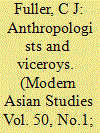|
|
|
Sort Order |
|
|
|
Items / Page
|
|
|
|
|
|
|
| Srl | Item |
| 1 |
ID:
144220


|
|
|
|
|
| Summary/Abstract |
The anthropology of caste was a pivotal part of colonial knowledge in British India in the late nineteenth and early twentieth centuries. Denzil Ibbetson and Herbert Risley, then the two leading official anthropologists, both made major contributions to the study of caste, which this article discusses. Ibbetson and Risley assumed high office in the imperial government in 1902 and played important roles in policy making during the partition of Bengal (1903–5) and the Morley-Minto legislative councils reforms (1906–9); Ibbetson was also influential in deciding Punjab land policy in the 1890s. Contemporary policy documents, which this article examines, show that the two men's anthropological knowledge had limited influence on their deliberations. Moreover, caste was irrelevant to their thinking about agrarian policy, the promotion of Muslim interests, and the urban, educated middle class, whose growing nationalism was challenging British rule. No ethnographic information was collected about this class, because the scope of anthropology was restricted to ‘traditional’ rural society. At the turn of the twentieth century, colonial anthropological knowledge, especially about caste, had little value for the imperial government confronting Indian nationalism, and was less critical in constituting the Indian colonial state than it previously had been.
|
|
|
|
|
|
|
|
|
|
|
|
|
|
|
|
| 2 |
ID:
077128


|
|
|
|
|
| Publication |
2007.
|
| Summary/Abstract |
Since 1991, when the policy of economic liberalisation began in earnest, the size and prosperity of India's middle class have grown considerably. Yet sound sociological and ethnographic information about its social structure and cultural values is still sparse, and as André Béteille (2003a: 75) comments: 'Everything or nearly everything that is written about the Indian middle class is written by middle-class Indians…[who] tend to oscillate between self-recrimination and self-congratulation' (cf. Béteille 2003b: 185). The former is exemplified by Pavan Varma's The Great Indian Middle Class (1998), which excoriates this class for its selfish materialism and the 'retreat from idealism' that was manifest in the smaller, 'traditional middle class' of the earlier, post-independence period (ibid.: 89). A good example of the opposite tendency is Gurcharan Das's India Unbound (2002), which celebrates 'the rise of a confident new middle class' (ibid.: 280). Das's diagnosis of what has changed is actually very similar to Varma's, but he insists that the new middle class is no 'greedier' than the old one, and the 'chief difference is that there is less hypocrisy and more self-confidence
|
|
|
|
|
|
|
|
|
|
|
|
|
|
|
|
| 3 |
ID:
121945


|
|
|
|
|
| Publication |
2013.
|
| Summary/Abstract |
A hundred years ago, pre-puberty marriage for girls was the norm among South Indian Tamil Brahmans, and Brahman girls received little or no education. By the 1940s, child marriage had largely ended and girls' education was improving gradually. Today, girls' educational standards more or less match that of boys', and many Brahman women are also employed outside the home. In relation to marriage and education in particular, the position of women has greatly improved, which is regarded by Tamil Brahmans themselves as a sign of their modern, educated, professional, middle-class status, whereas extreme gender inequality formerly indicated their traditional, high-caste status. This paper examines how female marriage, education, and employment are interrelated and how they have changed among Tamil Brahmans, particularly in the Eighteen-Village Vattima subcaste, which continued child marriage until the 1970s. Among Tamil Brahmans, as both women and men recognize, a real reduction in gender inequality has occurred. Moreover, Brahman men have more readily ceded status to Brahman women than Brahmans together have to non-Brahmans, so that there is a striking contrast today between persisting ideas of caste superiority and diminishing gender inequality.
|
|
|
|
|
|
|
|
|
|
|
|
|
|
|
|
|
|
|
|
|